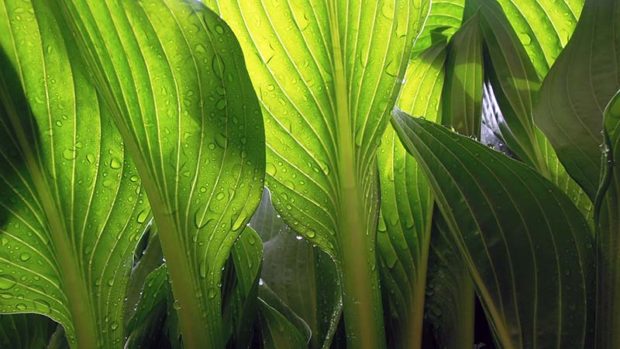
by Nancy Szerlag
Slugs are the bane of many gardeners’ existence. In the dark of night these slimy characters chew away at the garden, leaving it in tatters by sunup. A mild winter combined with a cool, wet summer can send the dastardly slug population soaring. And a single slug will eat 30 to 40 times its weight in vegetation daily, so a handful of slugs can do a great deal of damage in a short period of time.
Ridding the garden of slugs is a hard fought battle for many gardeners. Commercial slug baits containing metaldehyde are not recommended because they are highly toxic to small animals, children and birds. Also, if used regularly, the slugs seem to build up immunity to the ingredients.
Beer traps (tin cans filled with fresh beer, or a solution of sugar, water and yeast) will lure the slugs to their demise by drowning, but they attract only those sliming around in close proximity to the slug saloon. If you have a large garden, to get any measure of control you have to set out a lot of traps and they need to be cleaned and refilled every few days.
Products with iron phosphate are both effective and easy to use for controlling slugs. Plus, some are organic products that will not harm pets and wildlife. Iron phosphate breaks down to become part of the soil, and is combined with an effective lure that slugs consider a tasty treat.
Because slugs feed mostly at night, it’s best to apply the iron phosphate products in the evening. Slugs like damp areas, so if the soil is dry, wet it before applying. While the granules will not dissolve in the rain, they must be reapplied as they are consumed. To be truly effective the product needs to be in place as the slug eggs hatch out, so it should be reapplied according to package directions throughout the summer. A very heavy infestation of slugs may take two years or more to control.
We are better able to combat slugs effectively, like any garden pest, if we become familiar with their feeding habits and life cycle. Unfortunately, slugs (like worms) are hermaphroditic, having both male and female sex organs, so every slug that reaches adulthood in the garden has the potential of procreating more slugs by laying anywhere from 20 to as many as 100 eggs once or possibly twice a year.
When digging in the dirt, should you come upon a cache of tiny translucent spheres that look like little plastic beads sitting in the soil, you have found a stash of slug eggs. I often find them in the soil under decorative stones and containers that sit in the garden. When I find a mass of eggs, I crush them between my gloved fingers or carefully scoop them up and dump them in the trash. In spring when the ground warms, the eggs hatch and the tiny slugs immediately become active feeders. Mature slugs are able to overwinter in the soil and are ready to feed as soon as tender shoots emerge from the soil in spring.
So, unlike the Integrated Pest Management strategy used for most garden insects, where products are not recommended for use until the insect damage becomes unsightly, if your garden suffered slug damage last year, you should begin control measures as soon as the hostas and other plants poke their noses through the soil in spring.
Using their rasp-like mouth parts, slugs bore through the leaves, fruit and flowers of many plants, leaving telltale round holes behind. Other signs that slugs are at work are the trails of shiny, silvery dried slime left on the surface of the soil. Slugs are particularly fond of hostas, petunias and delphiniums. The leaves of hostas under attack will soon look like Swiss cheese.
Slugs do most of their feeding at night, although they are also active on cool, overcast, rainy days. Because slugs seek shelter in soil cracks and under debris during the day, many gardeners never see them and mistakenly blame other insects for their damage. Treatment with a broad-spectrum pesticide is useless because these insecticides are ineffective for use on slugs, which are members of the mollusk family. However, insecticides unfortunately do kill off a slug’s natural predators, including rove beetles, daddy long legs spiders, centipedes, fire fly larvae and soldier beetles—this helps to increase the slug population. Thus, avoid this scenario.
To check for slugs, peruse the garden with a flashlight a couple of hours after sundown. Be sure to look at the undersides of leaves. Some gardeners enjoy hand-to-hand combat, and delight in hand-picking and dropping their prey in cans of soapy water. But hand-picking can be tedious and tiny hatchlings are easily missed in the dark of night.
It’s not always necessary to treat an entire garden for slug infestations because there are certain plants that are slug resistant. Artemisia, bleeding heart, coral bells, tickseed, goatsbeard, lamb’s ears, candytuft, foxglove, Jacob’s ladder, and most herbs seem to be immune. However, common slug targets include begonia, hollyhock, marigold, primrose, violets, bellflower, geranium, daylily, iris and snapdragon. Lettuce, cabbage and rhubarb are favorite foods of slugs, along with the fruits of strawberries and tomatoes. Ivy and succulents are also prime dining fare.
As a shade gardener and grower of hostas, I’ve battled slugs for a number of years and tried many organic controls including beer traps, organic dusts and repellents. They all work to a degree, but to be truly effective they need to be attended and monitored on almost a daily basis. I don’t have that kind of time. But the iron phosphate products have given me the time to stop and smell the roses. I am happy to say I am finally winning my war on slugs in an environmentally friendly manner.
Nancy Szerlag is a Master Gardener and Master Composter from Oakland County, MI.

Leave a Reply